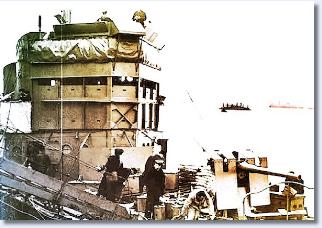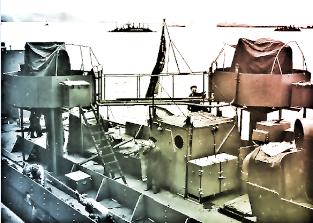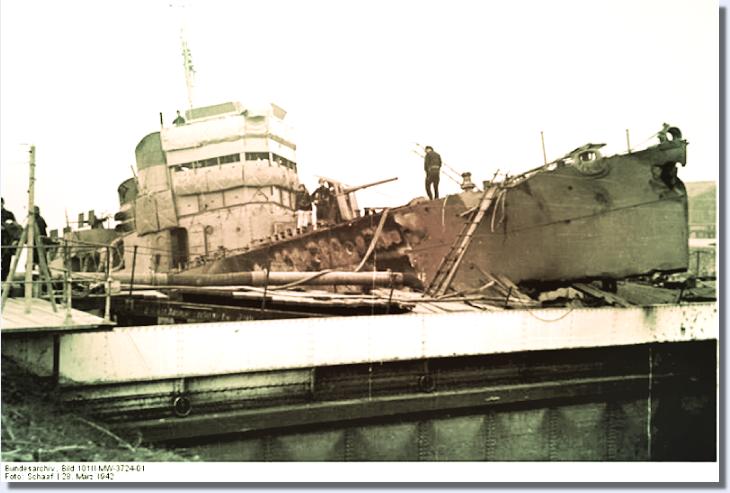 |
|||||
 |
|||||
HMS Campbeltown - Build details and Crew


SPECIAL ALTERATIONS FOR 'CHARIOT'
To minimise the effect of alterations on her draught, all unnecessary ammunition and fittings were removed, and Campbeltown shipped only sufficient fuel and water for a one-way trip. To allay suspicion ashore, however, she was stored as though to feed the crew for a return voyage.
Her four triple torpedo tubes were removed, as was her main armament of 4” guns, her depth-charges and their throwers and traps. To give her the silhouette of a German Möwe class boat her two aft funnels were cut down and blanked off, and her forward two funnels cut back at a slant. As the forward funnel of the German vessel was larger than its companion, Campbeltown’s forward funnel was also enlarged. To trap and drag torpedo nets rather than have them pass underneath and foul the screws, a large hook was fitted at the base of her stem.
As the essence of the attack plan was to achieve surprise and thus pass safely by the medium and heavy German coastal batteries before being engaged by lighter anti-aircraft guns, Campbeltown was armed only with light weapons. A total of eight 20mm Oerlikon cannon were shipped, four on the Midships Gun Platform, two on elevated bandstands above the main deck, and two on the Aft Deckhouse. The 12-pounder normally mounted on the Aft Deckhouse was moved to the Fo’c’sle and single .5” Browning machine-guns were mounted on either bridge wing. Two Commando teams would crew 3” mortars mounted on the foredeck to port and starboard of the bridge. To mitigate the effect of searchlights, the ship was painted in a dusky shade of mauve known as Plymouth, or Mountbatten, Pink.
To give side – but not overhead - protection to the Commandos who would by lying on her deck as the ship approached the lock gate, 4 rows of armour plating were fixed to the deck amidships. The bridge and wheelhouse were also encased in splinter mats and ¼” case-hardened steel plate, leaving only vision slits for Captain and helmsman exposed. This was judged to give adequate protection against missiles of up to 20mm, though even the lighter German batteries would also possess 37mm
This rather desolate Bundesarchiv image taken shortly before she exploded with heavy loss of life to German personnel on board and in the immediate dry dock area, shows the extreme precision with which Campbeltown was driven into the outer caisson of the 'Normandie' dock. With her bow astride the gate the way was clear for her Commando parties to scramble down the ladders shown on either side. The image also shows two men standing casually beside the 12-pounder gun-shield, just a handful of metres above the ship's undiscovered four-plus ton (total weight) demolition charge.....
Lt Cdr Stephen Halden 'Sam' Beattie, RN
Lt Christopher Hugh Clare Gough, RN
Lt Nigel Thomas Bethune Tibbits, RN
Gunner (T) Mr Harold Hargreaves, RN
W/Engineer Wilfred Harry Locke, RN
Surg. Lt William James Winthrope, RCNVR,
Chief PO Henry Percival Booth, RNZN
Chief PO Albert Percy Wellsted, RN
PO Steward Albert Edward Love, RN
PO William James Newman, RN
PO Telegraphist Harry Berwick Scott, RN
PO William F. 'Bill' Stocker, RN
A/PO Leslie Kemp, RN
Signalman R Teeling
Signalman Albert Westwell, RN
Telegraphist N Robinson
Telegraphist A.H. Jones
Yeoman D.G. Stanford
Leading Steward A.R Gooch
Steward Alfred Salter
Cook Walter Edward Rainbird
Ordinary Cook T.R. 'Roy' Bryant
Ordnance Artificer Frank Wherrell, RN
Leading Seaman Ronald James Bailey, RN
Leading Seaman Peter Mawby, RN
Able Seaman Alfred Sydney Baker, RNVR
Able Seaman Ernest William Bennett, RN
Able Seaman Douglas Frank Bowman, RN
Able Seaman D.C. Clark
Able Seaman J Crook
Able Seaman Jim W 'Bill' Demellweek
Able Seaman R Ferguson
Able Seaman Thoman Findlay, RN
Able Seaman William Ritchie Findley, RN
Able Seaman D Garlick
Able Seaman Samuel Walter Giles, RN
Able Seaman Victor Howard, RN
Able Seaman Frank Hutchin
Able Seaman Joseph Miller, RNVR
Able Seaman Harry Elvin Nelson, RN
Able Seaman A Paton
Able Seaman Allenby Rollin, RN
Leading Seaman James Smith, RN
Able Seaman D White
Able Seaman H Wood
Ordinary Seaman Harold Edward Bott, RN
Ordinary Seaman E Davidge
Ordinary Seaman B.V Nelthorpe
Ordinary Seaman Alexander Ross, RN
Chief ERA Harry Howard
ERA Horace John Reay, RN
ERA Richard Ruthven Nelson, RN
Sto. PO Reginald Joseph Charles Hodder, RN
Sto. PO E. Archie Pitt, RN
Sto. PO Daniel Charles Pyke, RN
Sto. PO Reginald Francis Underhill, RN
Sto. PO Albert Thomas Frederick Wade, RN
A/Sto. PO John William Purver, RN
L/Stoker Claude William Hyston Baxter, RN
L/Stoker William Henry Berry, RN
L/Stoker William C Brenton, RN
L/Stoker J Mennell
L/Stoker Frank Edgar Pritchard
L/Stoker D.E Turner
L/Stoker Leonard John Newbold, RN
L/Stoker James Bernard Reville, RN
Stoker (11) David Manning Vyall, RN
Stoker B Barnes
Stoker J.S Cutter
Stoker A Dawn
Stoker R.G Hancock
Stoker P.G Mayes
Stoker R Richards
Stoker Harry Albert Stevens, RN
Stoker J. Venture
Mr James Bourne, NAAFI

Builder – Bath Iron Works, Bath, Maine: Launched – January 2, 1919: Commissioned – January 20, 1919 Beam – 30’ 8” (9.24m): Displacement – 1090 tons standard: 1154 tons laden: Length – 314’ 4 1/2” (95.8m) Draught – 9’ 1 3/4” (2.8m) ave: weight of armour etc plus the tendency of her stern to squat at speed would bring this perilously close to the maximum depth of shoal water in the estuary. Shaft horsepower – twin shafts: 24,200 horsepower at 430rpm: Length – 314’ 4 1/2” (95.8m) Speed – 35 knots max: Range – 3,400 nm at 20 knots: Crew – normally 120 plus, reduced to 76 for the raid Armament – 8 x 20mm single Oerlikons: 1 x 12-pounder: 1 x single .5” machine-gun in each bridge wing Operational history – decommissioned June 7 1922, and spent the next 8 years in reserve. Recommissioned April 1930. Decommissioned again April 1937. Recommissioned September 1939 and transferred to RN service in the 1st Town Flotilla, as HMS Campbeltown, September 9, 1940, at Halifax Nova Scotia. Committed to Operation CHARIOT, March, 1942. |
|||
'The Destroyer Campbeltown', Al Ross, 1990 |
|||
All material contained in this site is subject to copyright and must not be reproduced in any format without the consent of the relevant copyright holder
Campbeltown's armoured bridge and wheelhouse.
Oerlikon mountings 5 & 6, above armoured screens
Build details, HMS Campbeltown/USS Buchanan

